The Denver Post: The water under Colorado’s Eastern Plains is running dry as farmers keep irrigating “great American desert”

IDALIA, CO – SEPTEMBER 12: Kenny Hellling readies his field to plant winter wheat on September 12, 2017 in Idalia, Colorado. Hellling, whose family has been farming in Yuma County more than 100 years, is serving on the Republican River Water Conservation District hoping to help find answers to the area’s on-going water battles. (Photo by RJ Sangosti/The Denver Post)
By Bruce Finley | October 8, 2017
Farmers say they’re trying to wean from groundwater, but admit there are no easy answers amid pressures of corn prices, urban growth and interstate water agreements
WRAY — Colorado farmers who defied nature’s limits and nourished a pastoral paradise by irrigating drought-prone prairie are pushing ahead in the face of worsening environmental fallout: Overpumping of groundwater has drained the High Plains Aquifer to the point that streams are drying up at the rate of 6 miles a year.
The drawdown has become so severe that highly resilient fish are disappearing, evidence of ecological collapse. A Denver Post analysis of federal data shows the aquifer shrank twice as fast over the past six years compared with the previous 60.
While the drying out of America’s agricultural bread basket ($35 billion in crops a year) ultimately may pinch people in cities, it is hitting rural areas hardest.
“Now I never know, from one minute to the next, when I turn on a faucet or hydrant, whether there will be water or not. The aquifer is being depleted,” said Lois Scott, 75, who lives west of Cope, north of the frequently bone-dry bed of the Arikaree River.
A 40-foot well her grandfather dug by hand in 1914 gave water until recently, she said, lamenting the loss of lawns where children once frolicked and green pastures for cows. Scott has been considering a move to Brush and leaving her family’s historic homestead farm.
“This will truly become the Great American Desert,” she said.
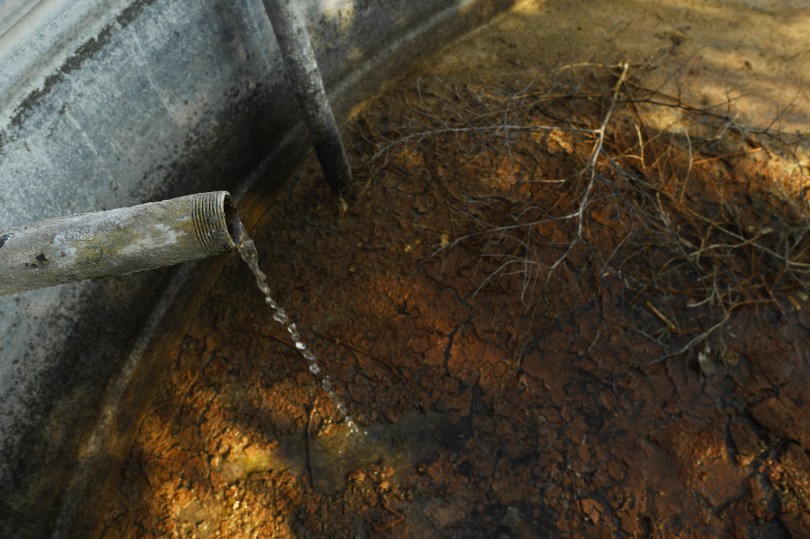
WRAY, CO – SEPTEMBER 12: Employees of New Banks Pumps fixed a stock tank well on September 12, 2017 in Wray, Colorado. They were able to get the well working again, but only less than a foot of water was measured in the well hole, leaving the rancher with only a trickle of water to fill the tanks for his cattle. (Photo by RJ Sangosti/The Denver Post)
The agricultural overpumping from thousands of wells continues despite decades of warnings from researchers that the aquifer — also known as the Ogallala, the world’s largest underground body of fresh water — is shrinking.
Even if farmers radically reduced pumping, the latest research finds, the aquifer wouldn’t refill for centuries. Farmers say they cannot handle this on their own.
But there is no agreement among the eight affected states (Colorado, Kansas, Nebraska, New Mexico, Texas, Oklahoma, Wyoming, South Dakota) to try to save the aquifer. And state rules allow total depletion.
In fact, Colorado officials faced with legal challenges from Kansas over dwindling surface water in the Republican River have found that their best option to comply with a 1942 compact is to take more water out of the aquifer. The state bought wells from farmers during the past decade and has been pumping out 11,500 acre-feet of water a year, enough to satisfy a small city, delivering it through a $60 million, 12-mile pipeline northeast of Wray to artificially resuscitate the river.
The overpumping reflects a pattern, seen worldwide, where people with knowledge that they’re exceeding nature’s limits nevertheless cling to destructive practices that hasten an environmental backlash.
The drawdown
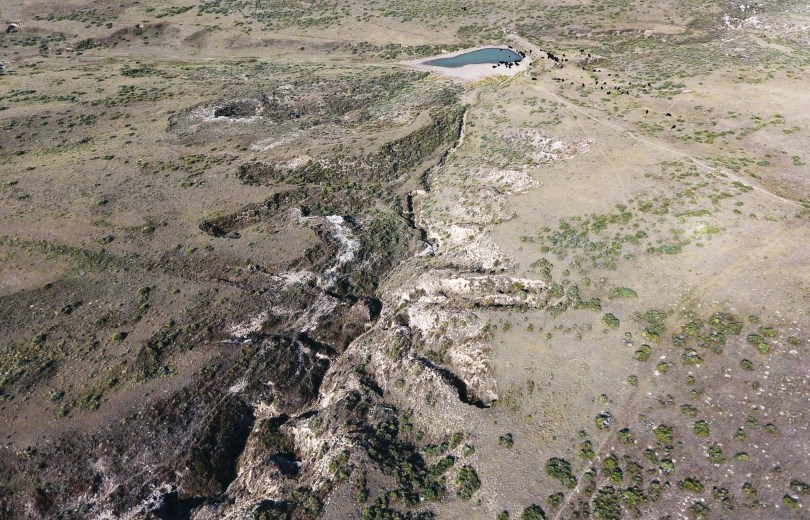
BURLINGTON, CO – SEPTEMBER 12: Cattle gather around a water hole at a ranch north of Burlington on September 12, 2017 in Burlington, Colorado. The feeder stream from the South Fork Republican River, one of three tributaries that originate in the High Plains of Northeastern Colorado, is slowly drying up. (Photo by RJ Sangosti/The Denver Post)
The depletion of the High Plains Aquifer has been happening for decades, according to bulletins U.S. Geological Survey has put out since 1988. Colorado farmers this year pumped groundwater out of 4,000 wells, state records show, siphoning as much as 500 gallons a minute from each well to irrigate roughly 580,000 acres — mostly to grow corn, a water-intensive crop.
The depth where groundwater can be tapped has fallen by as much as 100 feet in eastern Colorado, USGS data show. That means pump motors must work harder to pull up the same amount of water, using more energy — raising costs for farmers. The amount of water siphoned from the aquifer since 1950 to irrigate farm fields across the eight states tops 273 million acre-feet (89 trillion gallons) — about 70 percent of the water in Lake Erie.
On one hand, the industrial center-pivot irrigation techniques perfected after World War II have brought consistency to farming by tapping the “sponge” of saturated sediment that links the aquifer to surface water in streams and rivers. America’s breadbasket produces $35 billion of crops a year. On the other hand, intense irrigation is breaking ecosystems apart.Overpumping has dried up 358 miles of surface rivers and streams across a 200-square-mile area covering eastern Colorado, western Kansas and Nebraska, according to U.S. Fish and Wildlife-backed researchers from Colorado State University and Kansas State University who published a peer-reviewed report in the Proceedings of the National Academy of Sciences. The researchers also determined that, if farmers keep pumping water at the current pace, another 177 miles of rivers and streams will be lost before 2060.
“Intermittent streams are more likely to be dry. Permanent streams are more likely to become intermittent. Large streams are more likely to be small. Everything has changed,” said KSU conservation biologist Keith Gido, one of the authors. “We have almost completely changed the species of fish that can survive in those streams, compared with what was there historically. This is really a catastrophic change.”
Disappearing fish species — minnows, suckers, catfish that had evolved to endure periodic droughts — signal to biologists that ecological effects may be reaching a tipping point.
The amount of water held in the aquifer under eastern Colorado decreased by 19.6 million acre-feet — 6.4 trillion gallons — from 1950 until 2015, USGS records show. That’s an average loss of 300,000 acre-feet a year. Between 2011 and 2015, records show, the water available under Colorado in the aquifer decreased by 3.2 million acre-feet — an annual average shrinkage of 800,000 acre-feet. Climate change factors, including rainfall, play into the rate of the drawdown.
If all pumping stopped immediately, it would still take hundreds of years for rain-fed streams and rivers to recharge the aquifer, Gido said.
“We’re not living in as sustainable a fashion as we need to be. Much of the damage has been done,” he said, “and restoring what we’ve lost could be difficult.
“It is happening all over the world in places such as Pakistan. It causes conflicts. As human populations grow, the demand for water is going to be greater. Conflicts are going to increase — unless we become more efficient in using the water we have.”
Farmers locked
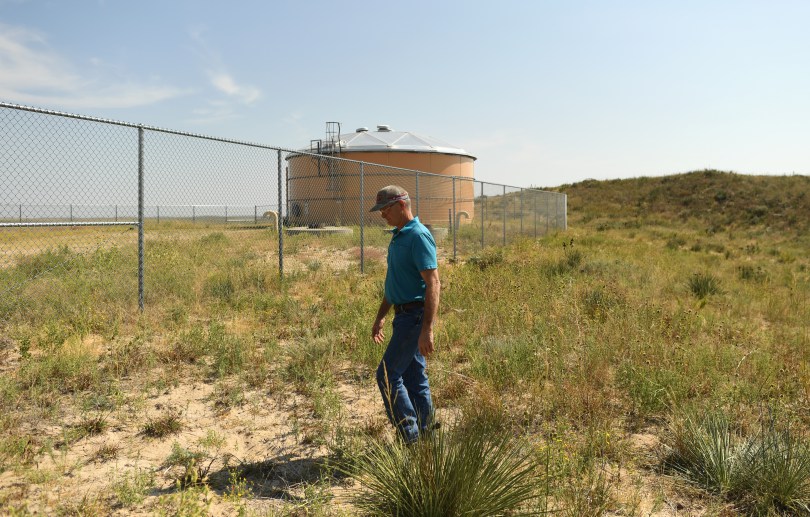
WRAY, CO – SEPTEMBER 12: Rod Lenz, president of the Republican River Water Conservation District, walks pass a storage tank filled with water that will free-flow down a pipeline to a outfall at the Republican River on September 12, 2017 in Wray, Colorado. The water delivery is part of the Republican River Compact among Colorado, Kansas, and Nebraska. (Photo by RJ Sangosti/The Denver Post)
For farmers, weaning themselves off groundwater is proving difficult.
They say they’re trying. They’ve reduced the land irrigated in eastern Colorado by 30,000 acres since 2006. They plan to retire another 25,000 acres over the next decade, said Rod Lenz, president of the Republican River Water Conservation District, who for years has advocated use of technology to grow more crops with less water.
“We have come to realize that, yeah, we are overmining it. We are acutely aware of that now. There’s a definite attitude to make more than just the natural progression as far as efficiency,” Lenz said, noting state officials monitor pumping and determine how many acres owners can irrigate.
“We’re constantly trying to find ways to stay in compliance,” he said. “We’re looking at serious conservation.”
For years, agriculture experts have pointed to drip-irrigation technology to do more with less. Federal agencies in the past dangled help for farmers who invest. But few in eastern Colorado have installed these systems, largely because they are expensive.
Farmer and cattleman Robert Boyd, a leader of the Arikaree Groundwater Management District, said the federal government should intervene to ensure survival of High Plains agriculture.
“Do you want us to be sustainable? Or not? It may come to a point where no one can actually irrigate,” Boyd said.
He pointed to proposals to divert water from the Missouri River Basin and move it westward through pipelines across the Great Plains.
“If the federal government wants agriculture to be sustainable, they need to pump water back toward the mountains. They need to figure out how to get water back toward the higher parts of the rivers,” he said. “The federal government needs to step in and make the states work together to make agriculture — and urban areas — sustainable.”
For now, farmers struggle, increasingly weighing water uncertainties in calculations that include corn prices falling to around $3.50 a bushel in recent years from $7. But drawing down the aquifer does not violate any law in Colorado. The state engineer’s office monitors well levels and requires permits for wells, limiting the number of acres a farmer can irrigate. But there’s no hard limit on how much water can be pumped.
In contrast, state rules limit groundwater withdrawals from the Denver Basin Aquifer — a source for many of Denver’s southern suburbs, including Castle Rock and Parker — to less than 1 percent a year. This is meant to help natural recharge keep pace with human demands.
But on the High Plains, the situation is like mining intended to fully exploit diamonds or gold.
“If you want to have it all back the way it was 150 years ago, you would have to remove everyone from the area. I’m not sure how we could do that today,” deputy state engineer Mike Sullivan said in an interview.
Sullivan and state engineer Kevin Rein emphasized that thousands of acres no longer are irrigated. “And there need to be some more retirements of land to get us into a more balanced situation,” Sullivan said.
They defended Colorado’s practice of pumping more groundwater out of the aquifer, saying this is necessary to comply with the Republican River Compact. Disputes over river flows have risen as far as the U.S. Supreme Court and Colorado’s legal obligations to deliver water to Nebraska and Kansas are clear.
“What we do with the pumping does help the streams,” Sullivan said. “It does provide a wet stream. … We could not meet our (legal) obligation without that today, even if we turned off all the wells.”
But there’s no end in sight for the drawdown of groundwater.
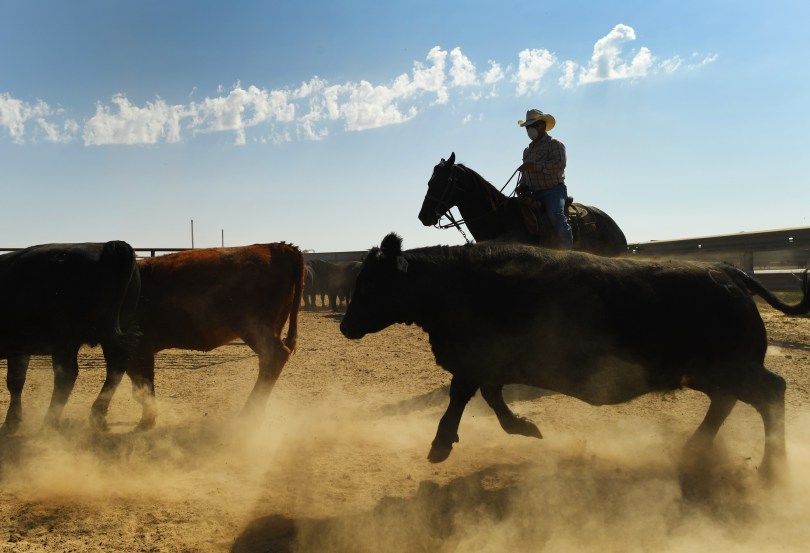
IDALIA, CO – SEPTEMBER 13: Dust flies up as Oscar Ortiz, a pen rider at Cure Feeders, works with the cattle on September 13, 2017 in Idalia, Colorado. The Cure family ranch sold water rights to 54 of their wells to the Republican River Water Conservation District. The water from those wells is now pumped to a holding tank that will free-flow down a pipeline to a outfall at the Republican River as part of the Republican River Compact among Colorado, Kansas, and Nebraska. (Photo by RJ Sangosti/The Denver Post)
Nature exhausted
And for farmers who built their world on the High Plains Aquifer, the environmental fallout is increasingly painful. In the rural view, it is a problem that cannot be addressed by farmers alone without help from people in cities. All of the industrial agriculture is done with urban residents in mind — the people who consume the crops and cows that farmers grow.
“The world population is going to double. And we’re not going to be able to grow more farmland. We’re losing farming ground every day to development,” said Cody Powell, manager of 21st Century Equipment, the John Deere dealer in Burlington, an agricultural hub. “You take away farm ground for development, bring in more people. Who’s going to feed them? The only way to do that is to put water on crops.”
People in cities increasingly demand environmentally correct crops, which requires more water. “If they want natural grain-fed cattle, and non-GMO (genetically modified organism) crops — all that good stuff — it is going to take water,” he said.
A farmer can grow more by using pesticides and genetically modified seeds, he said. “With the same amount of water, you could get twice as much corn.”
He knows too well the perils of losing water. He grew up in southern Colorado’s Arkansas River Valley at a time when Aurora and other Front Range suburbs were buying up rights from farmers. This buy-up to slake growing suburban thirsts ended up killing agriculture across hundreds of thousands of once-irrigated acres.
And now when Powell goes back, he sees communities “overrun with thugs” near where his grandmother lived. “It makes me feel sick,” he said.
In eastern Colorado, the problem now is that few can afford to invest in high-efficiency water technology, such as irrigation drip tubes and tape installed underground to eliminate evaporation losses, and soil-sensor systems that let farmers irrigate only when absolutely necessary.
Federal programs to subsidize installation of this technology have withered. And the overpumping continues.
“The fear out here now is not that the aquifer is going to get ruined,” Powell said. “The fear is that the state is going to shut off wells.”
And prairie residents practically cringe to see the pipeline northeast of Wray that Colorado uses to convey groundwater away to Nebraska and Kansas to prevent future lawsuits.
The interstate compact was negotiated back when there was more water and far fewer people, they say.
“Now we just have weeds. We are feeling the effect of losing the water that Kansas is enjoying,” Scott said from her farmhouse. “It is robbing families of life. That’s what is happening to us. We should be entitled to the water underground.”
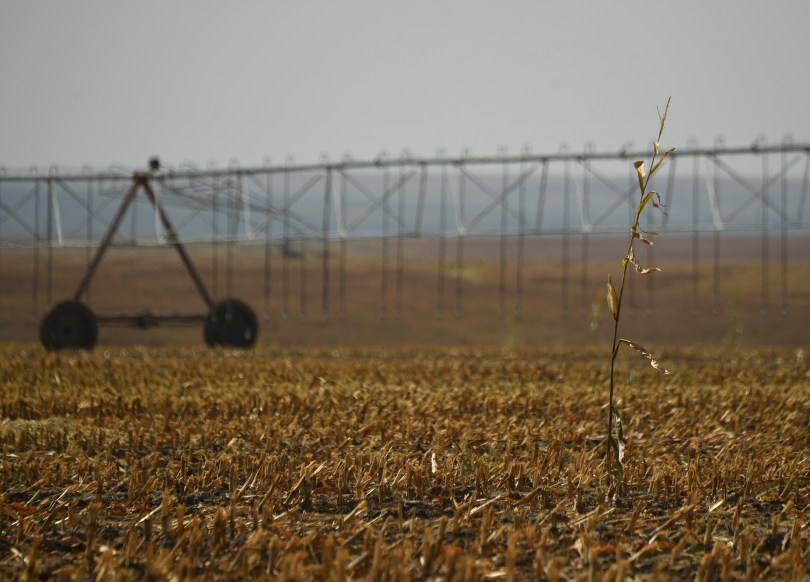
IDALIA, CO – SEPTEMBER 12: A single stock of corn stands in a field, in Yuma County, after harvest on September 12, 2017 in Idalia, Colorado. The area is in an on-going battle for water with neighboring states. (Photo by RJ Sangosti/The Denver Post)
Past becomes future
The depletion means water scarcity increasingly dictates survival.
It is no surprise to historians. In the 1860s, John Wesley Powell’s surveys for the U.S. government warned that the land west of central Kansas was practically a desert. His report “On the Arid Lands of the Western United States” warned that the only way for people to live here would be by irrigating land. Otherwise, he wrote, the place could not support permanent communities. Tribes for centuries used the Great Plains seasonally as a hunting ground.
Settlers flocked in during the 19th century, initially relying on dryland farming. This led to massive soil erosion, culminating in the Dust Bowl environmental disaster of the 1930s.
Industrial irrigation took off during the 1960s, with tens of thousands of wells drilled through the 1980s.
But now, if people keep pumping, the dry-out will intensify, CSU senior research scientist Kevin Bestgen said.
“I appreciate it that people now are trying to reduce pumping. The reality is that the bucket they are pumping from does not refill. It is finite. And in order to allow recharge of that aquifer, farmers are going to have to get much more severe reductions in pumping levels. It has been going down and down and down,” he said. “People are getting what they can. This will turn out to be a tragedy. It is in the culture at this point. People want to grow corn now.”
Groundwater levels
The map shows the change in groundwater levels for various management districts in the Northern High Plains Basin over the last 10 years. The water level data is collected from wells in the areas. Click an area to see the changes in groundwater levels for 1-, 5- and 10-year periods.
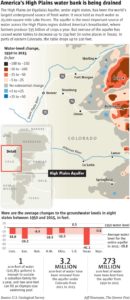
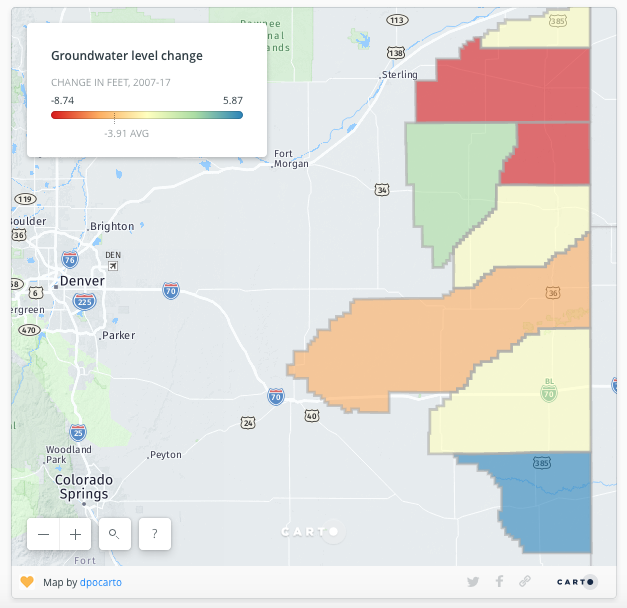
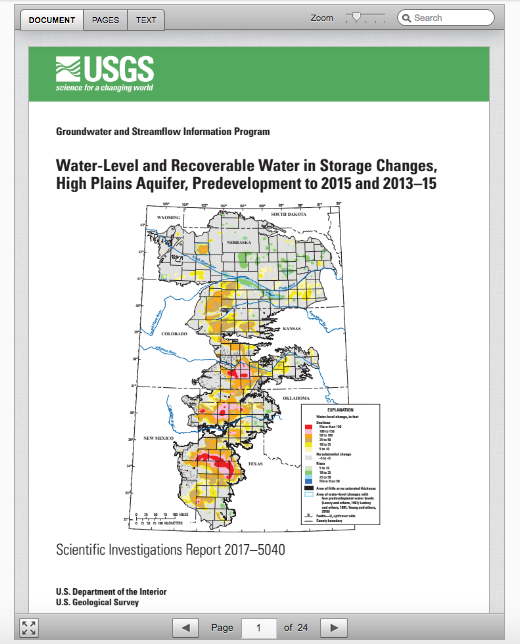
tragedy of the commons
For more see: http://nobull.mikecallicrate.com/2017/07/16/vice-meathooked-and-end-of-water/